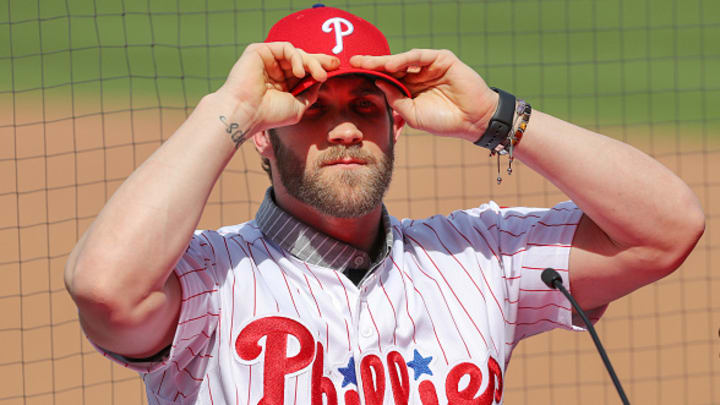Bryce Harper's First Choice Wasn't the Phillies, But They Gave Him What He Wanted: Stability

CLEARWATER, Fla. — Bryce Harper was the Phillies’ first choice, but it was clear at his introductory press conference on Saturday that they weren’t his. Not because he initially mis-buttoned his brand-new, red-pinstriped jersey, before grinning and trying again. Not because he struggled to remember the Philadelphia traditions he’d been taught to reference. (“I want to be on Broad Street, in a frickin’ boat, or whatever it is,” he said, to laughter.) Not even because he let a “We want to bring a title back to D.C.” slip near the end.
At times he seemed well practiced. Why Philadelphia? The family atmosphere. Why no opt-out? He’s in it for the long haul. Why jersey No. 3? He thought the late Roy Halladay should be the last Phillie to wear 34, and third baseman Maikel Franco already owned his second choice, No. 7. Does $330 million over 13 years—the most lucrative contract in North American sports history—strike him as an absurd amount of money? “I think baseball’s worth about 11 and a half billion dollars. I think some of it should go back to the players.” Those were a snap. But then: How had he prepared for this moment?
Harper has long sought the spotlight, but sometimes he seems uncomfortable in its glare. He spoke Saturday from a folding chair atop the first-base dugout at Spectrum Field. From the netting behind him hung his 2009 SPORTS ILLUSTRATED cover, on which he was featured as a 16-year-old as BASEBALL’S CHOSEN ONE; his 2019 cover of the MLB: THE SHOW video game; and his ESPN the Magazine World Fame 100 cover. He flips his bat and wears his hat backward and insists that he can help “make baseball fun again.” But sometimes you get the sense that he would rather just go to work, then return home at night to watch Netflix with his wife, Kayla.
“From Day 1, when I got drafted, it was all about, He’s going to the Yankees,” the rightfielder said. “He’s going to the Dodgers. He’s going here. He’s going there. For six years, it’s all everybody talked about. It’s all anybody wanted to talk about. They wanted to talk about this moment. And for me, going through this process, it was, Where can I be with no opt-outs, a no-trade—where I can be for a long time, and not have to worry about going anywhere else? Because for me, when I was in D.C., I didn’t want to go anywhere else. I didn’t want to be part of two organizations, or anything like that. And that just didn’t work out. But now I’m going to be part of an organization for 13 years, and put all my faith and trust in everybody in this organization, and I’m very excited about that, because nobody in the next 13 years is going to be talking about, Oh, he’s going to the Yankees. He’s going here. He’s going there."
Harper spoke openly toward the end of last season, his final one with the Nationals, about his desire to remain with the organization that drafted him first overall in 2010.
“I’ve always said: If I’m in those plans, I’d absolutely love to be here,” Harper told The Washington Post in September. “But if I’m not, there’s nothing I can do about it. There’s nothing I can do. I would love to play next to [Victor] Robles or [Juan] Soto or [Adam] Eaton. I’d love to. But am I in those plans? I have no idea.”
Washington reportedly offered Harper a 10-year, $300 million deal that month, but his agent, Scott Boras, has said that the amount of deferred money in that contract would have lowered its real value to $184 million. There was never any chance Harper would sign for that. He has not been the best player of his generation, as fans once dreamed he might, but he is only 26 and a six-time All-Star. His 2015 MVP season was one of the greatest in baseball history. Still, he cherished his time in D.C.—and the idea of entering the Hall of Fame without having to make a choice about the cap on his plaque.
The other teams that courted Harper flew to Las Vegas to meet with him near his home. But in deference to his relationship with Ted and Annette Lerner, the owners of the Nationals, Harper and Boras had lunch on their turf, in Palm Springs, Calif.
In the end, the Nats could not—or would not—offer him what he had earned, so he looked for someone who would. The finances of the three teams in the mix were all competitive: The Giants are said to have offered 12 years and $310 million, and the Dodgers were in reportedly in the range of $180 million over four years, which would have allowed him to hit the market again at 30. But the Phillies, he said, gave him what he sought most: a place to end his career. They agreed to a no-trade clause. Harper’s camp has insisted that he never sought and in fact actively discarded the idea of an opt-out clause.
“Even through the bumps and the bruises, I want to be part of that as well,” Harper said. “For me, it was all about the long haul. It was about being able to dig my roots, being able to plant somewhere I wanted to be for a long time. I said that in D.C. when I was there, as well. I said I wanted to be somewhere for a long period of time, and we went through that whole process, and it just didn’t work out. It didn’t happen.”
Harper finished his press conference and the hour or so of follow-up interviews. Then he walked off the field, turning his hat backward as he went, so the last part of him that disappeared into the tunnel was the Philles logo.
